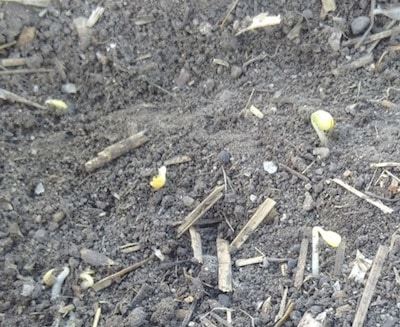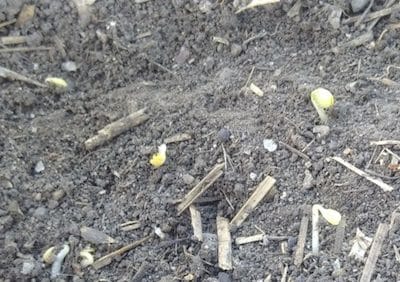
Step one in the pre-seed weed control plan is to see what weeds are present — annuals, perennials, winter annuals — and at what numbers. Choose a product based on which weeds present the biggest threat to yield based on their number and size.
Products approved for use ahead of canola
Bromoxynil has been shown to have better activity on volunteer canola than carfentrazone, but legume species (like black medick) will tolerate bromoxynil alone, so carfentrazone is better on these weeds. The combination of bromoxynil and carfentrazone is quite complimentary and generally gives better overall control than either alone. For more on this, see the section below “Conquer or CleanStart?”
With the discovery of glyphosate-resistant kochia in all provinces on the Prairies, it is important to apply glyphosate with a tank mix partner. Exceptions are in crop on glyphosate-tolerant canola where no tank mix options exist.
Water volumes. Glyphosate is systemic, and can be effective at lower water volumes and coarse to extra coarse spray qualities. Carfentrazone and bromoxynil are contact and benefit from higher water volumes and medium to coarse spray qualities. Nozzle manufacturers publish the spray qualities of their nozzles in their catalogues and apps.
When mixing with glyphosate, consider the efficacy of the tank mix partner when setting water rates and droplet size. After all, if the tank mix partner wasn’t important, you would use straight glyphosate.
Use at least 5 gal/ac and closer to 10 for improved efficacy. One way to make finer droplets with the same nozzles is to increase ground speed. By doing so, the rate controller will increase pressure which will reduce droplet size and may improve performance of contact product.
Water quality. Hard water tends to reduce glyphosate performance, especially at higher water rates. When tank mixing with glyphosate and increasing water volume, it is important to consider water quality. Send water to a testing lab. If “total hardness” is below 350 ppm (or 20 “grains”), the water source is good as is. For harder water, a conditioner such as spray-grade ammonium sulphate can be added to negate the effect of hard water cations.
Spraying in cold weather. Applications of glyphosate and many other herbicides made in cold conditions often result in poor weed control. For example, cloudy days with highs of 10°C after a night near 0°C will often result in poor herbicide performance. Biological activity would have stopped when temperatures drop below 5°C and would not start up again until the plant warmed to at least 5°C — and even then it would be very slow. No biological activity means no herbicide activity. Ideally glyphosate applications will be made: —When temperatures are greater than 10°C, with the expectation that daytime highs will increase to greater than 15°C —When nighttime lows are greater than 5°C (the warmer the better up to 10°C) —Under bright sunshine (thin or sporadic clouds are also OK). Applications made in darkness or heavy cloud are less effective.
How long to wait to seed after spraying?
Glyphosate only: For annuals and winter annuals, glyphosate needs only 24 hours to get to the growing point. After a day, the crop can be seeded. For perennial weeds, 3 days should be enough in sunny and warm conditions but 5 days is recommended before seeding if weather is cloudy or cool.
Contact herbicides: Generally the activity of contact herbicides such as bromoxynil and carfentrazone is very quick (within hours), so seeding the following day is appropriate. Contact herbicides for use prior to canola are not very effective on perennial weeds so leaving them for an extended period will not provide improved efficacy. Most contact herbicides are recommended to be mixed with glyphosate and those wait periods will be the most limiting in most cases.
Sprayer clean out. During the pre-seed weed control season, take care to thoroughly clean the sprayer on a regular basis to remove active ingredients that could damage crops when you go back to the fields in a few weeks for in-crop applications. A good rule of thumb is to clean the sprayer any time the power plant of the sprayer needs to be shut down. Pay extra attention to screens and boom ends where residue tends to sit. MORE
Conquer or CleanStart? Because of the value of glyphosate to current farming systems and the possibility of selecting for glyphosate-resistant weeds, using straight glyphosate is rarely recommended anymore unless absolutely necessary (in crop on a Roundup Ready crop, for example). To protect against selection pressure for herbicide resistance, the common practice is to use multiple modes of action. Conquer with glyphosate is a three active solution (Groups 6, 9 and 14), giving it an edge over CleanStart, a two active solution (Groups 9 and 14.) Conquer also provides faster, more complete control of glyphosate-tolerant volunteer canola, and better control of kochia, wild buckwheat, narrow-leaved hawks beard, cleavers and thistle.
NuFarm, which provides both products, says “CleanStart is a simple one step solution to resistance an improved weed control. Conquer provides a more sustainable solution with faster, more complete weed control in all situations.”
Price: CleanStart’s suggested retail price is $7.83/ac (glyphosate included) and Conquer’s suggested retail price is $6.88/ac plus glyphosate at $3/ac for the half-litre rate.
Slowing down and increasing water volumes will improve the performance and return on investment for the contact active ingredients (Groups 6 and 14).
Further reading:
Canola Encyclopedia section on pre-seed burnoff

